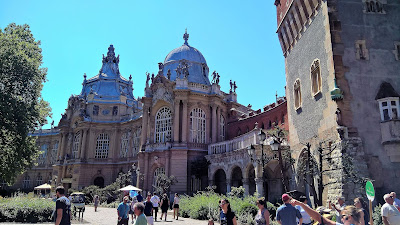
Recently in the news, we've seen controversy over Confederate statues being taken down in the United States, some as a result of local consensus and some through mob violence.
In Hungary, this symbolic cleansing of its past has been more common.
Five statues of Habsburgs, including Maria Theresa, formerly stood among the Hungarian heroes in Budapest's City Park.
Constructed in 1896 to commemorate the 1,000 year anniversary of the arrival of seven Magyar leaders and their Central Asian tribes into the Carpathian Valley to conquer and settle what is now Hungary, Heroes' Square was the impressive first stop of our AmaWaterways excursion into Budapest.
Our arrival by river had already intrigued us with the beautiful cityscape of Hungary's capital, including the world's largest and arguably most beautiful Parliament Building.

On a distant hillside, we could also see the Liberation Monument, constructed seventy years ago to “perpetuate the memory of Soviet soldiers fallen in the liberation of the capital city of Budapest."
They did, however, place a counterbalancing statue of U.S. President Ronald Reagan, whom they credit for helping them win their freedom, facing the Soviet monument directly, although we couldn't see that from the ship.

 We traveled by modern tour bus to Heroes' Square (Hősök Tere), which includes the Hungarian War Memorial along with assorted hero statuary.
We traveled by modern tour bus to Heroes' Square (Hősök Tere), which includes the Hungarian War Memorial along with assorted hero statuary.Only two of the hero statues remain in their original spots: Árpád, who was one of the seven Magyar clan lords who arrived in 896 AD, and Saint Stephen, the first King of Hungary, who was crowned on Christmas Day in the year 1000.
Other statues, including those of five Habsburgs, have come and gone, or sometimes simply been relocated, as regimes went through some rather sweeping political swings including monarchism to communism to Nazi-ism and back to communism and finally democratic freedom.
 The Habsburgs, regardless of what anyone may think of royalty in general or the sometimes enlightened and often self-aggrandizing rule of Maria Theresa's family specifically, were without question significant figures in Hungarian history. I would have liked to find them included.
The Habsburgs, regardless of what anyone may think of royalty in general or the sometimes enlightened and often self-aggrandizing rule of Maria Theresa's family specifically, were without question significant figures in Hungarian history. I would have liked to find them included.
To learn more about the Hungarian heroes who are represented by statues, please click the different hotlinks above.
The wars that usually brought about these changes in hero statues also brought about death and destruction.
For the same Millennial Expo of 1896, which incidentally occurred when Austro-Hungary remained under Habsburg rule, also brought about the construction of Vajdahunyad Castle near Heroes' Square.
Based primarily on the Hunyard Castle of Transylvania (also part of the Habsburg's Austro-Hungary), it contains several architectural styles representing great buildings of the region.
Romanesque, Gothic, Renaissance and Baroque building styles are all represented in this castle on a small island accessed by a faux drawbridge across a moat.
Originally built as a temporary exhibit of cardboard and wood, it became so popular that between 1904 and 1908 that the castle was rebuilt in brick and has continued to be a popular attraction ever since.
This forerunner of Disneyland proved people enjoy fantasy recreations of castles and beautiful architecture, a lesson not lost on Walt Disney or, in most recent years, the newly emerging industrial powerhouse, China.
Approaching the castle you'll see a serene lake, where you can rent paddle boats that look like cars.
In the winter, the lake freezes and becomes an ice skating rink.
It seems to be a pretty good re-imagining of an area that used to be a swamp.
Another attraction located in the same park is the Budapest Zoo and Botanical Garden, which was not included in our tour.
There are also restaurants in the area, so you could easily spend the day in Budapest's City Park, but we had only begun our day ashore.
"Better service leads to better trips!"








 |
| Soviet Era Buildings Approaching Budapest (Repainted Post-Communism) |











No comments:
Post a Comment